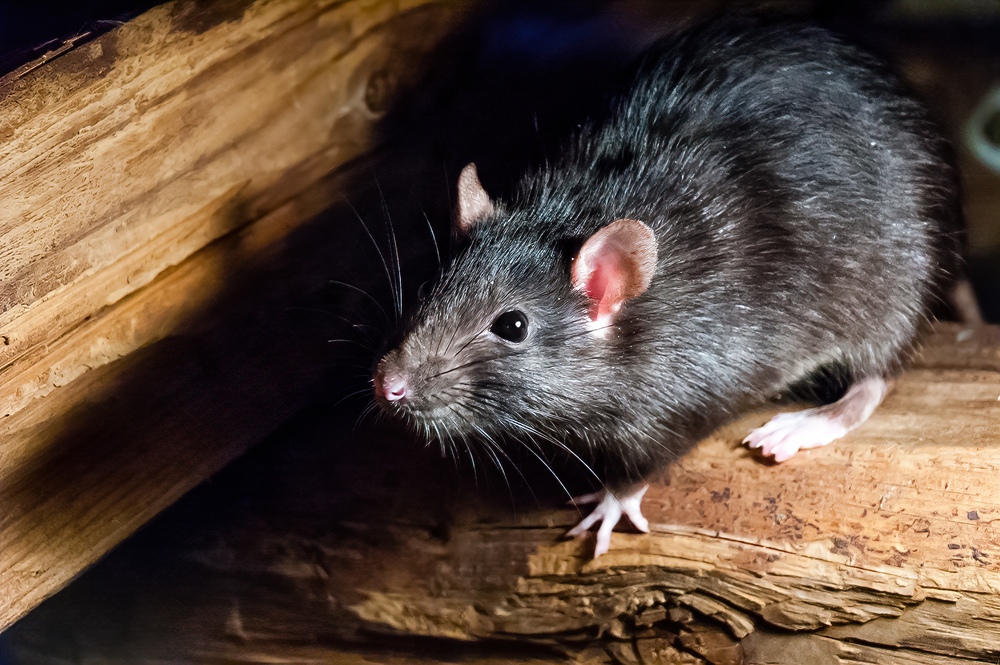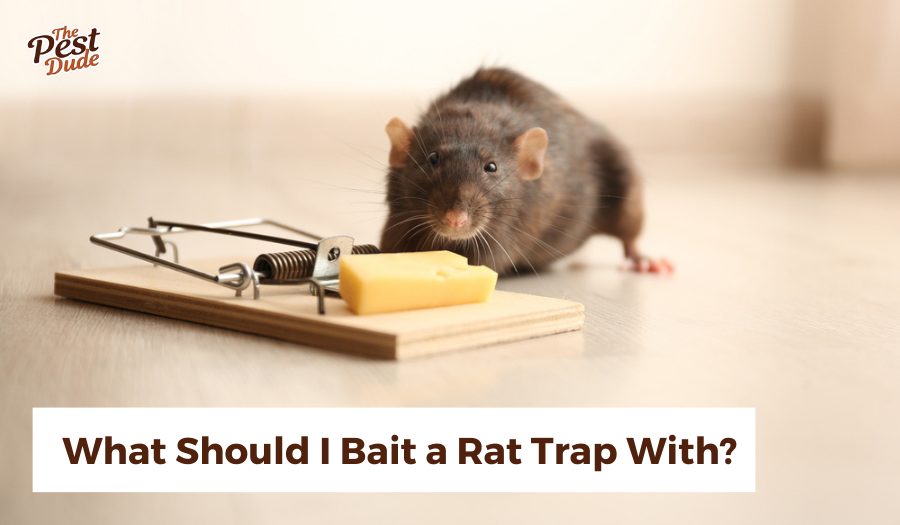Discovering the presence of rats in your home is unsettling.
Rats are dirty and destructive. They also carry diseases that make people and pets sick.
To get rid of them, you have to start a trapping program – and fast.
Unfortunately, most homeowners aren’t sure how to begin or what to bait rat traps with.
Don’t worry – you don’t have to figure it out alone.
Here at Pest Dude, we have more than 15 years of experience in the pest control industry, and we’ve compiled our knowledge into this extensive guide to help you learn how to bait rat traps.
Key Takeaways
- To bait rat traps, use fresh food lures or chemical rodent baits.
- To reduce the risk of accidental ingestion by kids, pets, or non-target species, enclose chemical rodent baits in bait stations.
- For help getting rid of large or pervasive rat infestations, contact a professional pest management company.
Before You Get Started

1. Understand Rat Behavior
Norway rats and roof rats are both intelligent creatures who prioritize seeking shelter and warmth.
While many believe rats are ravenous and it’s easy to control them by simply choosing the right bait – this isn’t true.
In fact, because rats eat a wide variety of foods, they’re seldom hungry. This makes it difficult to catch or kill them by relying solely on rodenticides or traps baited with fresh food lures.
In our experience, you must understand two things to control rats effectively. Namely, that rats are curious and cautious.
Rats fear and avoid new things, have obsessive habits, and are inherently curious about their environments.
With these traits in mind, you must place your traps in the right areas and prepare them appropriately.
2. Season Traps with Rat Scent
To effectively catch rats, it is crucial to “season” traps with rat scent.
Rats have a strong sense of smell and rely on scent trails to navigate their surroundings. They instinctively avoid anything that doesn’t smell like them. If a new trap is introduced without any rat scent, they will simply steer clear of it.
To season traps, we often recommend collecting rat feces (wear gloves!) from nesting and feeding sites and placing it around the traps. Additionally, it’s important to note that the process may take longer than expected – several days or even weeks in some cases.
If you’re experiencing difficulties with rats evading your traps, seeking assistance from a professional pest management company is highly recommended. These experts understand rat behavior and can help you outsmart these pests, allowing you to reclaim a rat-free home.
For more information on rat behavior, the difference between Norway and roof rats, and how to trap each species effectively, check out this guide.
3. Use Toxic Baits With Caution
A word of warning: toxic baits, while effective, are incredibly dangerous. These baits can pose significant risks to children, pets, and native wildlife.
When using toxic bait, follow the manufacturer’s instructions carefully and ensure that children, pets, and non-target species cannot access the bait. Consider using bait stations to minimize the risk of accidental ingestion.
Whenever possible, use non-toxic bait alternatives (like snap traps set with food lures) and ensure that any chemical baits are used responsibly and in accordance with local regulations.
How to Select the Most Effective Bait for Your Rat Trap

When it comes to baiting, you can choose between fresh food and chemical baits. Each has its own set of advantages and potential drawbacks.
Here’s what you need to know:
Fresh Food Baits
Using fresh food to bait traps can be an effective way to control rats. When using fresh foods to bait traps, do your best to match the food bait to whatever food(s) the rat is feeding on.
Examples may include:
- Fresh Fruits: Apples, bananas, and berries can be quite attractive for omnivorous roof rats.
- Nutella or Peanut Butter: These spreads have a strong aroma that can lure rats from a distance.
- Cheese: Strong-smelling or moldy cheese can be effective when used as bait.
- Fresh Vegetables: Carrots, peas, or corn are often used as rat bait.
- Meats: Small pieces of bacon or chicken can be very effective.
- Pet Food: Wet cat or dog food can be irresistible to rats – especially Norway rats, who love meat- and fish-flavored pet food.
- Bread or Cereals: Bread and dry cereal are attractive, mess-free foods that are perfect for baiting traps.
Best for: A wide variety of rat species in households that either want to avoid chemical baits altogether or use food lures to mix with toxicants.
Pros: Affordable, easy to access, easy to replenish.
Cons: May require frequent reapplication as it can dry out, can be attractive to kids, pets, and non-target species.
Chemical Rodent Baits
For some, the natural route might not cut it. Fortunately, chemical baits offer another level of effectiveness by using specially formulated substances that attract and kill rats quickly.
Today, there are a variety of commercially manufactured rodenticide food baits available, which usually contain mixtures of common grains, like wheat, oats, corn, and sorghum, and are packaged in pellet bait, loose meal bait, packet-style bait, and block bait formulations.
Here’s a breakdown of each:
- Packet baits: These baits contain small amounts of meal or pellet sealed in a plastic, paper, or cellophane package. They are ready to use and have a longer shelf life than other bait formulations. Additionally, they provide a visual confirmation of rodent activity as mice have to chew into the packet to access the bait. However, it is essential to note that packet baits can also attract non-target wildlife, companion animals, and children.
- Block and pellet baits: These baits are convenient and moisture-resistant, making it easy for rodents to pick up, handle, and consume. However, they can also be easily carried off and hoarded by rodents in wall voids or nests, raising concerns about pesticide translocation.
- Loose meal baits: While less prone to pesticide translocation than pellet baits, these baits tend to absorb moisture from the air. Therefore, they should not be used in damp or humid areas as they can quickly spoil.
Best for: Severe infestations where natural baits have failed.
Pros: High efficacy, easy to use and set.
Cons: Risky if other non-target animals or children are around, highly toxic, must be used with extreme caution.
Baiting Techniques
To increase the efficacy of your traps, make sure you’re baiting them properly. Here are a few of our top tips:
- Choose strong-smelling food lures. Use strong-smelling food baits like vanilla extract, nuts, fish, moldy cheese, or peanut butter to bait your traps. Rats will be able to smell these baits from far away and are more likely to travel to your traps to consume them.
- Remove other food sources. Make sure the rats you’re trying to trap are hungry by removing as many nearby food sources as possible.
- Mind the spacing. Think about rat foraging ranges as you set and bait your traps. We recommend 15-50’ spacing between traps. If the infestation is severe, err on the side of placing traps closer together – rather than further apart. Additionally, place your bait between rat harborage and foraging areas whenever possible.
- Change bait according to rat preferences. To encourage bait rats to consume your bait, experiment with different food lures, and don’t be afraid to try something new if the bati you’ve chosen isn’t working.
Want to Get Rid of Rats in Your Home? We can Help!
Nobody wants to share their home with rats.
Fortunately, you don’t have to live with these pests forever!
If your DIY options have failed or you want professional help, working with a local pest control company is your best option.
Pest Dude has a wide network of reputable pest control professionals in your area.
Call us at (844) 532-0076 and we’ll connect you with a professional in your area who can help you eliminate rats.
FAQs
If your rat bait isn’t working, consider making a few adjustments (and reread the section above on rat behavior).
Firstly, try changing the bait type, as rats have diverse dietary habits and might not be attracted to your current choice.
To increase the chances of bait acceptance, try experimenting with different food lures and change them regularly if the chosen bait proves ineffective.
Secondly, reposition your traps in locations where you’ve noticed signs of rat activity. Remember, rats are neophobic (fearful of new objects), so it might take a while before they start interacting with the trap. With this in mind, keep traps undisturbed and in place for a few days.
Lastly, ensure the bait is fresh and appealing. If the problem persists, it might be time to consult a professional pest control service.
There are several types of rat traps available, each with its own advantages.
Here are some of the most common:
- Snap Traps: These traps use a spring-loaded metal bar to kill rats when they step on the trap’s baited plate. They’re effective and affordable, although they present a snap risk for kids, pets, and whoever is setting the trap.
- Plastic Enclosed Snap Traps: These are a safer version of the traditional snap trap. In these traps, the snap mechanism is enclosed within a plastic box, which minimizes the risk of unintended harm to non-target species or humans and pets.
- Live Catch Traps: Also known as “catch and release” traps, these are ideal for those who prefer a humane method. These traps capture rats alive so they can be relocated.
- Electric Traps: These high-tech traps use a high-voltage shock to kill rats instantly. They are usually battery-operated and reusable.
- Glue Traps: These are a simple but somewhat controversial type of trap. They use a sticky surface to trap rats in place. However, they are considered inhumane by some, as they cause rats to die slowly.
In addition to traps, some people also use bait stations to get rid of rats. While traps capture or kill rats, bait stations serve as protective housing for poison bait. Their unique design ensures that the toxic bait is inaccessible to non-target species, children, and pets, thus mitigating the risk of accidental poisoning.
Bait stations do not trap or instantly kill rats. Instead, the rats visit the station to feed. Once they ingest the poison, they typically die a few days later.
Bait stations can effectively tackle larger rat populations, but they require careful monitoring to replenish the bait and dispose of deceased rats properly.
Placement of Traps
The placement of rat traps is crucial for trapping success. Always place traps in areas with high rat activity, which can be indicated by droppings, gnaw marks, signs of nest activity, or grease trails.
Common places include:
- Along walls (rat runways usually follow walls since rats dislike moving through open spaces)
- Behind appliances
- In dark corners
Safety Precautions & Dangers
Safety is paramount when working with rat traps.
Always wear gloves when handling traps to avoid contamination and prevent your scent from deterring rats.
If you’re using chemical baits in your traps, keep them out of reach of children and pets to prevent accidental ingestion.
Do’s and Don’ts
Do’s:
- Check traps regularly. A dead rat left in a trap could attract other pests or deter rats from visiting other traps.
- Clean and deodorize traps after each use. Rats can smell the scent of a dead rat and will avoid the trap.
- Use different types of traps if one isn’t working. Rats are smart and can learn to avoid certain traps.
Don’ts:
- Touch a live rat. They can bite or carry diseases.
- Dispose of a dead rat without protective gear. Always wear gloves and a mask, and wash your hands and clothing after any contact with a rat.
Common Mistakes
- Wrong Trap Size – Many people mistakenly use mouse traps for rats because of their similar design. However, rat traps are considerably larger and more powerful to account for the size difference between rats and mice. Using a mousetrap on a rat increases the risk of the rat escaping or being trapped and wounded but not killed.
- Ineffective Placement – It’s important to know that rats tend to stick to the edges of rooms near walls where they feel safe. Placing a trap in the middle of the room is unlikely to catch much. Instead, position the trap along the edge of the room with the trigger plate facing the wall to have a better chance of luring rats into the trap.
- Premature Trapping – Rats are highly aware of their surroundings, and introducing a new element can make them cautious. Place the traps in the room without setting them initially. This way, the rats won’t perceive them as a threat and will be more likely to approach the traps a few nights later.
- Insufficient Traps – Apart from acclimating the rats to the traps early, remember that once they realize the traps are deadly, they will avoid them. That’s why it’s crucial to set multiple traps. The first night statistically captures the most rats, so setting numerous traps overnight significantly increases your odds.
Rats are excellent climbers and can squeeze through spaces as small as a quarter, which makes them adept at finding entry points into your home.
They may enter through gaps in walls, doors, or windows, through ventilation systems, or via utility holes in the side of your home.
In homes with wooden siding, rats can gnaw their way into the building. They are also known to gain access through sewer pipes and drainage systems.
With this in mind, it’s essential to seal all potential entry points and keep your home’s perimeter as secure as possible to prevent rat infestations.
Regular inspection and maintenance of the property can also aid in early detection and prevention of rats.
Rats are extremely intelligent and they are capable of learning from their experiences.
If a rat manages to escape from a trap once, it is less likely to approach the same trap again.
Therefore, switching between different types of traps and bait can increase the chances of successfully capturing these clever rodents.

Get a Free Quote
Give us a call today to receive your free, no-obligation pest control quote.







